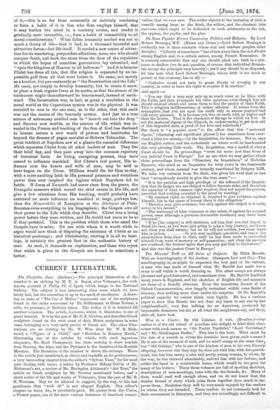CURRENT LITERATURE.
The Portfolio, June. (Seeleys.)—The principal illustration of the number is an etching by M. P. A. Rajon, after Velasquez, the well- known portrait of Philip IV. of Spain which hangs in the National Gallery. The subject is less interesting than some which we have lately had, but the execution is up to the mark of excellence. A draw- ing on stone of "The Car of folios" represents one of the sculptures found in the ruins excavated by Dr. Schliemann at Ilium Novum, a relic, we presume, of Hellenic times. The notice of it is deferred till another occasion. The article, however, which it illustrates is one of great interest. It is by the pen of Mr. C. T. Newton, and describes Greek sculpture found on the west coast of Asia Minor, sculptures in some cases belonging to a very early period of Greek art. The other illus- trations are an etching by Mr. W. Wise after Mr. W. B. Rich- mond, a "Figure of a Child," and "Sketches in Romney Marsh," illustrating one of the articles by which, with such ingenious eloquence, Mr. Basil Champneys has been seeking to draw tourists from Norway, the Alps, and the Pyrenees to the beauties of the Kentish Marshes. The literature of the number is above the average. There is the article just mentioned, as clever and readable as its predecessors; a very interesting chapter from the editor's "Sylvan Year," for the most part dealing with trees; a notice by Professor Sidney_ Colvin of Mr. Richmond's art, a review of Mr. Bevington Atkinson's "Art Tour," the article on Greek sculpture by Mr. Newton mentioned before, and a short notice of the life and works of Velasquez, from the pen of Mr. B. N. Wornum. May we be allowed to suggest, by the way, to this last gentleman that "took ill" is not elegant English. The editor's chapter on trees, Fa., is peculiarly good. He quotes from the Union, a French paper, one of the most curious instances of fanatical conser-
vatism that we ever saw. The writer objects to the intrusion of such a canaille among trees as the birch, the willow, and the chestnut into canvases which ought to be dedicated to such aristocrats as the oak, the cypress, the poplar, and the pine.


































 Previous page
Previous page